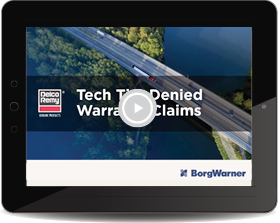No one likes having to file a warranty claim, so we’ve done our best to make it fast and easy—and that starts with helping you understand what’s covered and what’s not. To help, we asked Tim Stevens, Manager, Reliability Center, to list the top three claims that are regularly denied because they are not covered by warranty.
Denied Claim #1: Trouble Not Found
When a product is sent to our facility for a warranty claim, we perform up to three tests to assess performance and functionality. If it passes these tests, then we inspect the electrical connections. Tim says that many times, when it’s a “trouble not found” result, the failure has been incorrectly attributed to the starter or alternator—meaning it’s been improperly diagnosed, and the cause is elsewhere in the vehicle.
TIM'S RECOMMENDATION: Check the batteries and voltage drop in the cabling/connections, and make sure there’s no unusual corrosion, dirt, contamination or loose connections.
Correct any issues found prior to testing the alternator/starter.
Denied Claim #2: Prolonged Power Applied/Extended Abutment
This is another failure mode that is not covered by warranty. “It occurs when power is applied to the solenoid switch in an attempt to engage the engine ring gear for an extended period of time. This causes the solder at the solenoid switch terminal connection to reflow,” Tim explains. It’s caused by lower system voltage and pinion to ring gear abutment due to tooth damage.
TIM'S RECOMMENDATION: Use fully charged batteries and make sure there’s no excessive voltage drop. Additionally, visually inspect the ring gear for tooth damage, and replace it if damage is found.
Denied Claim #3: External Circuit Control Issues
External factors are also sometimes the culprit of the malfunction. These include:
- Loose or improper connections
- Wire routing that can damage the wire insulation
- Vehicle control system issues that send power to the integrated magnetic switch and cause severe milling of the drive pinion
- Vibration and corrosion
- Temperature changes
- Wiring performance
- Secondary components
TIM'S RECOMMENDATION: Inspect for evidence of loose electrical connections—broken, stripped or cross-threaded terminals. Also conduct preventative maintenance to the control circuit and wiring to reduce risk of engagement into rotating ring gear.
Learn more in our most recent Tech Tip Video.
 Unsure if Claim is Covered?
Unsure if Claim is Covered?
If you’re not sure if the problem you’re experiencing is due to a faulty starter or alternator or the result of something else, it’s best to start with these resources:
Tech Line:
800.372.0222 or
[email protected]